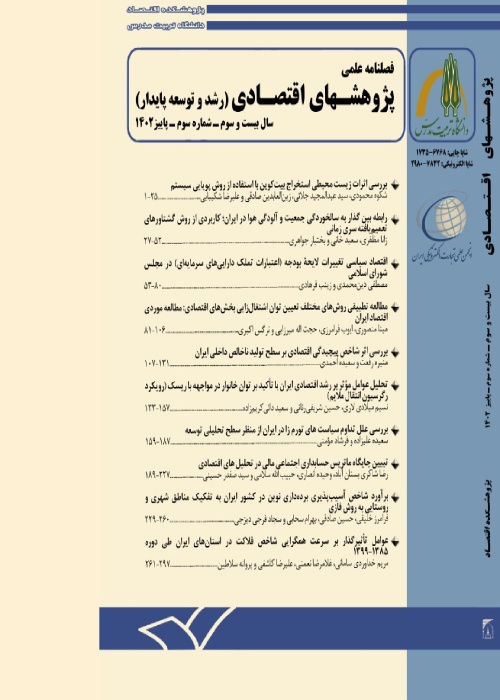Modeling the Impact of Monetary Policy with Different Patterns of Facility Repayment Rates on Macroeconomic Variables Using the Agent-Based Approach
The distribution of income and wealth in Iran is highly dependent on monetary policy. Iran's macroeconomic variables show that the country is experiencing an increase in inflation, liquidity and social inequality. Given that the facility repayment rate plays a role in channeling resources to investments, and given the role of the central bank in determining and regulating this variable in Iran, this study examines the impact of changing the facility repayment rate as a monetary policy tool on macroeconomics variables related to the distribution of income and wealth in society. The contribution of this research is to provide the agent-based model for Iran and to study the effects of different scenarios of decreasing, increasing and constant trend of facility repayment rate on the distribution of income and wealth, and other macroeconomic variables.
Two types of approaches can be used to model this problem: (1) simulation with the Dynamic Stochastic General Equilibrium (DSGE) approach and (2) simulation with the Agent-based Computational Economics (ACE) approach. DSGE models seek to find the optimal point, in which pricing is done through aggregating supply and demand by the Walrasian auctioneer, and none of the factors can decide on their variables. While in ACE simulations, changing process of variables and factors is examined and each factor has the ability to decide about its variables based on its observation of the system. The ACE approach has been used because of the proximity of the simulation to reality and the ability to examine the process. In this simulation, the effect of changing the facility repayment rate on the distribution of income and wealth and other macroeconomic variables is examined in three scenarios: decreasing, increasing and fixed facility repayment rate. Agents that are considered in the proposed simulation are: (1) The Central bank as policy-maker agent that decides about facility repayment rate and money supply volume, (2) The bank is responsible for allocating credit to firms and depositing from households and distributing income from banking activities among depositors. It is also the responsibility of the bank to sell consumer goods and capital of bankrupt companies that have not been able to repay their facilities, (3) Firms are responsible for the production of consumer goods and capital and its sale in the market, and (4) A household that provides its labor force to firms in exchange for wages and provides consumer goods for its livelihood in the consumer goods market. In this simulation, policy-making is done by the central bank and the existence of the government, and fiscal policies are ignored and only the mentioned monetary policy (facility repayment rate) is investigated.In this research, the market is defined in a way that each agent on the demand side observes a random list in terms of number of factors on the supply side and buys from the supplier agent that offers the lowest price. Model have 4 markets as follows:(1) the labor market, (2) consumer goods market, (3) capital goods market, and (4) credit market. The characteristic of this type of market is that the market mechanism is a random adaptation mechanism, and all agents on the demand side have incomplete information from suppliers and vice versa. None of agents see all the market prices and decide to buy only on the basis of incomplete observations of the system. Also, on the supplier side, the firm does not see the cumulative need of the market. It means that the firm estimates the amount of production for this period based solely on its own personal experience in the previous periods, and according to that estimate, it employs labor and produces goods and services. And firms set prices based on their experience on previous periods. This kind of market attitude in simulation has caused the simulated market to be closer to the real world.
The result of this simulation shows that the repayment rate of incremental scenario caused the collapse of the simulation system and also the Gini coefficient increased, which indicates the disparity in the distribution of income and wealth in society. The fixed scenario does not show an effect on improving the Gini coefficient and on the other hand causes the bankruptcy of many firms in the long run. The best result is the reducing scenario. In this scenario, the system achieved sustainable economic growth, controlled liquidity, and a reduction in the Gini coefficient.
In the absence of speculative markets, all the money generated in the banking system is directed to the production and development of economic activities. In addition, decreasing repayment rate of facilities can improve the distribution of income and wealth in society.
- حق عضویت دریافتی صرف حمایت از نشریات عضو و نگهداری، تکمیل و توسعه مگیران میشود.
- پرداخت حق اشتراک و دانلود مقالات اجازه بازنشر آن در سایر رسانههای چاپی و دیجیتال را به کاربر نمیدهد.



